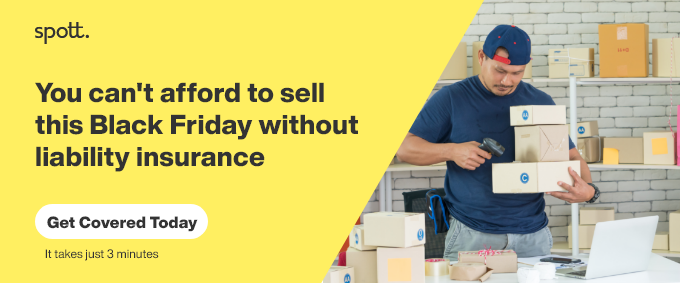Top 3 Pitfalls eCommerce Sellers Should Avoid This Black Friday and Cyber Monday
It’s that time of year again: Black Friday and Cyber Monday are almost upon us. Hopefully, you’re already well prepared, have got the right liability insurance in place, and your warehouse is well stocked. No matter how organized you...

It’s that time of year again: Black Friday and Cyber Monday are almost upon us.
Hopefully, you’re already well prepared, have got the right liability insurance in place, and your warehouse is well stocked. No matter how organized you are, it’s never too early to double check that all the boxes have been ticked. As the countdown to the two biggest days of the shopping year starts, let’s take a look at the three biggest pitfalls that eCommerce sellers face, and how to avoid them.

But First, The Numbers Behind Black Friday and Cyber Monday Sales
For eCommerce sellers, Black Friday and Cyber Monday are two of the most important days on the calendar. Last year, 88 million Americans shopped online during Black Friday, spending a whopping $8.9 billion.
Cyber Monday, which takes place three days after Black Friday, is even more of a juicy prospect: Last year, consumers splurged $10.7 billion on Cyber Monday, hitting a peak of $12 million every minute during the busiest hour (11pm-12am ET / 8pm-9pm PT).
With that level of consumer spending on offer, eCommerce sellers who get these two dates right can enjoy windfall profits, easily elevating revenue comfortably into the black, right on schedule to start building your brand further in 2023.
But that doesn’t mean it’s smooth sailing.
Let’s take a look at three of the most common pitfalls, and how you can avoid falling into these traps this holiday season.
1. Being inadequately insured
Insurance isn’t sexy, which makes it easy to overlook, but it is vitally important. Not having the right eCommerce insurance in place (or worse still, none at all!) can easily wipe out an eCommerce seller’s entire business if a customer makes a successful claim against you.
Because accidents can always happen no matter how careful you are to ensure your product is safe, Amazon now requires vendors to have Amazon seller insurance in place if your sales surpass $10,000 in any one month. The policy needs to cover Amazon as an ‘additionally insured’ party and carry at least $1,000,000 in coverage.
A good policy needs to adequately cover you if a customer is injured, or their property is damaged, because of a product that you have sold them. The cost of the policy will depend on two main factors.
The first factor is how likely your products are to cause damage. Clearly, some products are more dangerous than others. Anything with an electronic element has the potential to malfunction and start a fire, for example, while something like a knitted toy is probably pretty safe.
The second factor is how many units of each product you sell (known as ‘exposure’). If the chances of an accident happening due to your product is one-in-a-million, it probably won’t happen if you sell one, ten, or even 100 units. If you sell a million, chances are it will. It’s this factor that makes getting the right insurance in place so crucial at this time of year, because as your sales boom, so does your exposure.
You can make sure you get coverage with a policy that’s tailored to your specific needs as an eCommerce seller, by getting a quote through Spott.
2. Mismanaging Your Inventory Levels
There’s nothing more frustrating than having customers on your site wanting to buy, but being thwarted by ‘out of stock tags all over your product range. Last year, out of stock tags were up eight percent on Cyber Monday compared to the week before (November 22). But the bigger picture is that they were also up 169 percent compared to the 2020 figure, and up a staggering 258 percent compared to 2019’s figures. That points to the pandemic has had a serious impact on supply chains, a problem that still hasn’t been fully ironed out.
Historically, eCommerce sellers have calculated their ‘safety stock’ — the amount of excess stock they should hold to make sure they have enough in reserve — using the following formula:
(Maximum daily unit purchases X maximum product production time) — (average daily unit purchases X average product production time) = safety stock
While that still serves as a good rule of thumb, stay in close contact with your suppliers so that you can build resilience in to cover any delays they are still experiencing due to supply chain disruption.
When planning your Black Friday / Cyber Monday sales, don’t overlook packaging — right down to ensuring that you have enough tissue paper, stickers or tape to package your products to the standard the customer expects. There’s only one thing more frustrating than running out of stock, and that’s running out of boxes to ship the product in.
3. Failing to Build Trust
With so many consumers looking for new companies and products to delight them and their loved ones, Black Friday / Cyber Monday is the perfect time to gather and convert new leads.
They say first impressions count, and this holds true for eCommerce sales too. Online consumers are getting savvier about the potential pitfalls of shopping online. Those new leads will be on the lookout for the scams that sadly also abound at this time of year, or just for any signs that your product might disappoint. After all, they can head to your competitors with just one click.
Build instant trust with new customers by placing product reviews and testimonials front and center on each product page and on your main page, giving potential customers peace of mind that what they’re seeing on the screen really is what will arrive on their doorstep.
You can also build trust in advance, by running a focused social media campaign in the run up to Black Friday / Cyber Monday. Invite loyal customers to send in photos of themselves with your product, or to send in testimonials that you can use on social posts.
Better still, build a community of loyal customers ahead of time who can act as ambassadors during the holiday season. Facebook groups are a great way to get everyone talking – and allow you to build a buzz around certain products before they go on sale.

 AbJimroe
AbJimroe 












![5 Reasons Why Brands Lose Followers on Instagram [HubSpot Blog Data]](https://blog.hubspot.com/hubfs/losing-followers-on-instagram.jpg#keepProtocol)
![How to Write a Respectable Resignation Letter [+Samples & Templates]](https://blog.hubspot.com/hubfs/resignation-letter.jpeg#keepProtocol)



















